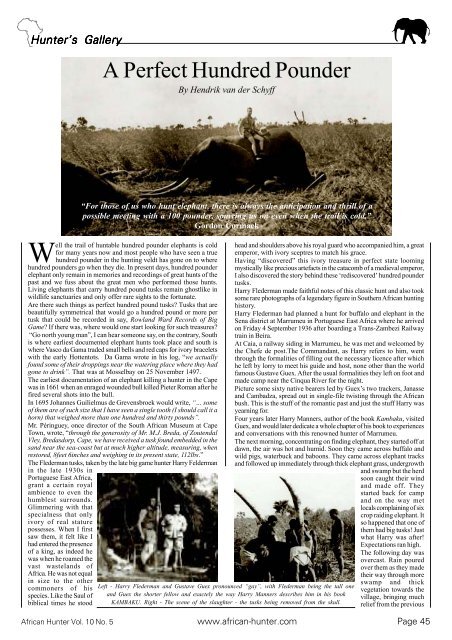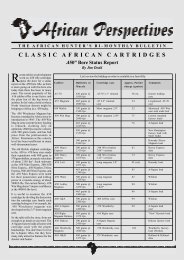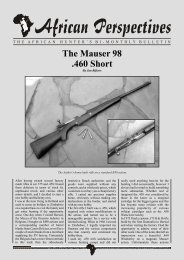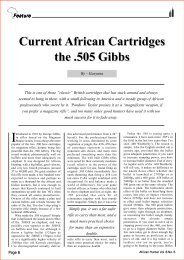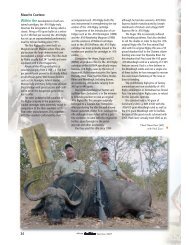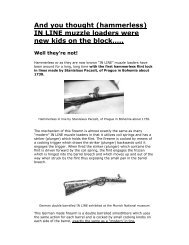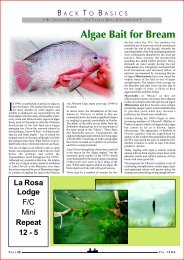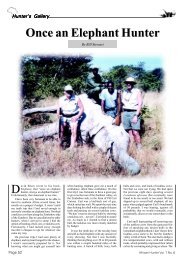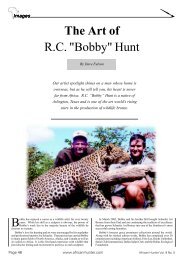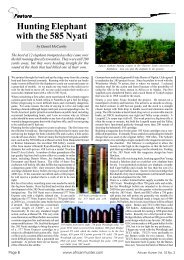Hunter's Gallery - HuntNetwork
Hunter's Gallery - HuntNetwork
Hunter's Gallery - HuntNetwork
You also want an ePaper? Increase the reach of your titles
YUMPU automatically turns print PDFs into web optimized ePapers that Google loves.
<strong>Hunter's</strong> <strong>Hunter's</strong> <strong>Gallery</strong> <strong>Gallery</strong><br />
<strong>Gallery</strong><br />
Well the trail of huntable hundred pounder elephants is cold<br />
for many years now and most people who have seen a true<br />
hundred pounder in the hunting veldt has gone on to where<br />
hundred pounders go when they die. In present days, hundred pounder<br />
elephant only remain in memories and recordings of great hunts of the<br />
past and we fuss about the great men who performed those hunts.<br />
Living elephants that carry hundred pound tusks remain ghostlike in<br />
wildlife sanctuaries and only offer rare sights to the fortunate.<br />
Are there such things as perfect hundred pound tusks? Tusks that are<br />
beautifully symmetrical that would go a hundred pound or more per<br />
tusk that could be recorded in say, Rowland Ward Records of Big<br />
Game? If there was, where would one start looking for such treasures?<br />
“Go north young man”, I can hear someone say, on the contrary, South<br />
is where earliest documented elephant hunts took place and south is<br />
where Vasco da Gama traded small bells and red caps for ivory bracelets<br />
with the early Hottentots. Da Gama wrote in his log, “we actually<br />
found some of their droppings near the watering place where they had<br />
gone to drink”. That was at Mosselbay on 25 November 1497.<br />
The earliest documentation of an elephant killing a hunter in the Cape<br />
was in 1661 when an enraged wounded bull killed Pieter Roman after he<br />
fired several shots into the bull.<br />
In 1695 Johannes Guilielmus de Grevensbroek would write, “… some<br />
of them are of such size that I have seen a single tooth (I should call it a<br />
horn) that weighed more than one hundred and thirty pounds”.<br />
Mr. Péringuey, once director of the South African Museum at Cape<br />
Town, wrote, “through the generosity of Mr. M.J. Breda, of Zoutendal<br />
Vley, Bredasdorp, Cape, we have received a tusk found embedded in the<br />
sand near the sea-coast but at much higher altitude, measuring, when<br />
restored, 8feet 6inches and weighing in its present state, 112lbs.”<br />
The Flederman tusks, taken by the late big game hunter Harry Felderman<br />
in the late 1930s in<br />
Portuguese East Africa,<br />
grant a certain royal<br />
ambience to even the<br />
humblest surrounds.<br />
Glimmering with that<br />
specialness that only<br />
ivory of real stature<br />
possesses. When I first<br />
saw them, it felt like I<br />
had entered the presence<br />
of a king, as indeed he<br />
was when he roamed the<br />
vast wastelands of<br />
Africa. He was not equal<br />
in size to the other<br />
commoners of his<br />
species. Like the Saul of<br />
biblical times he stood<br />
A Perfect Hundred Pounder<br />
By Hendrik van der Schyff<br />
“For those of us who hunt elephant, there is always the anticipation and thrill of a<br />
possible meeting with a 100 pounder, spurring us on even when the trail is cold.”<br />
Gordon Cormack<br />
head and shoulders above his royal guard who accompanied him, a great<br />
emperor, with ivory sceptres to match his grace.<br />
Having “discovered” this ivory treasure in perfect state looming<br />
mystically like precious artefacts in the catacomb of a medieval emperor,<br />
I also discovered the story behind these ‘rediscovered’ hundred pounder<br />
tusks.<br />
Harry Flederman made faithful notes of this classic hunt and also took<br />
some rare photographs of a legendary figure in Southern African hunting<br />
history.<br />
Harry Flederman had planned a hunt for buffalo and elephant in the<br />
Sena district at Marrumeu in Portuguese East Africa where he arrived<br />
on Friday 4 September 1936 after boarding a Trans-Zambezi Railway<br />
train in Beira.<br />
At Caia, a railway siding in Marrumeu, he was met and welcomed by<br />
the Chefe de post.The Commandant, as Harry refers to him, went<br />
through the formalities of filling out the necessary licence after which<br />
he left by lorry to meet his guide and host, none other than the world<br />
famous Gustave Guex. After the usual formalities they left on foot and<br />
made camp near the Cinqua River for the night.<br />
Picture some sixty native bearers led by Guex’s two trackers, Janasse<br />
and Cambadza, spread out in single-file twisting through the African<br />
bush. This is the stuff of the romantic past and just the stuff Harry was<br />
yearning for.<br />
Four years later Harry Manners, author of the book Kambaku, visited<br />
Guex, and would later dedicate a whole chapter of his book to experiences<br />
and conversations with this renowned hunter of Marrumeu.<br />
The next morning, concentrating on finding elephant, they started off at<br />
dawn, the air was hot and humid. Soon they came across buffalo and<br />
wild pigs, waterbuck and baboons. They came across elephant tracks<br />
and followed up immediately through thick elephant grass, undergrowth<br />
and swamp but the herd<br />
soon caught their wind<br />
and made off. They<br />
started back for camp<br />
and on the way met<br />
locals complaining of six<br />
crop raiding elephant. It<br />
so happened that one of<br />
them had big tusks! Just<br />
what Harry was after!<br />
Expectations ran high.<br />
The following day was<br />
overcast. Rain poured<br />
over them as they made<br />
their way through more<br />
Left - Harry Flederman and Gustave Guex pronounced “gay”, with Flederman being the tall one<br />
and Guex the shorter fellow and exactely the way Harry Manners describes him in his book<br />
KAMBAKU. Right - The scene of the slaughter - the tusks being removed from the skull.<br />
swamp and thick<br />
vegetation towards the<br />
village, bringing much<br />
relief from the previous<br />
African Hunter Vol. 10 No. 5 www.african-hunter.com Page 45
days intense heat. In due time the safari reached<br />
the kraal where the elephant were said to have<br />
caused damage and they decided to make camp<br />
further on. An old native from the village joined<br />
up with them and, together with Guex and Harry<br />
set off to follow the spoor. One animal indeed<br />
left enormous footprints as he went.<br />
Through the rain the trackers followed the trail<br />
of the elephants. Having hurt his leg previously,<br />
Guex was having trouble keeping up but as they<br />
came to very thick forest and bush the trackers<br />
got excited, a sure sign that the trail was getting<br />
hot. Harry climbed into a tree trying to see ahead<br />
over the bush and long grass and was delighted to<br />
spot the big bull and his five askaris feeding in<br />
the long grass not more than 300 yards away.<br />
The hunting party changed direction and<br />
approached the elephants from down-wind.<br />
Constantly checking the wind, Harry and<br />
Cambadza closed in trying to see if the big bull<br />
was endowed with big tusks but the very<br />
denseness of the grass and undergrowth made it<br />
difficult. But then the big bull raised its head revealing a pair of<br />
magnificent tusks. Harry was ecstatic but he couldn’t find a clear shot<br />
so decided to play it safe and retreat to get a better angle. They met up<br />
with Guex and the other trackers near a small anthill.<br />
From here on, I’ll let Harry tell the story:<br />
“Carefully made observation and saw quarry about a 100 yards off -<br />
took a glance through field glasses and admired huge tusker in front.<br />
Took careful sight in poor light along barrel of my 9.3 mm rifle and<br />
aimed for a heart shot. He staggered and then recovering from the<br />
shock bolted with the rest. We took shortcut to where elephants were<br />
heading and after careful stalking again saw them. The tusker was<br />
evidently hard hit and impeded the progress of the rest of his followers.<br />
After making another detour we again secured a favourable<br />
position on a slight rise. I aimed two shots for the<br />
temple at about 80 yards and was<br />
thrilled to see the big fellow collapse.<br />
Confusion now reigned in the<br />
elephant ranks and one fellow looking<br />
as big as a house and presenting a<br />
very awe-inspiring sight came plunging<br />
past us at a tangent about 15 yards off.<br />
(As Guex was in need of meat we were<br />
out to get as many of this bunch as we<br />
could.)<br />
We then opened fire on the rest but decided<br />
to spare a smaller bull. I brought down two<br />
others, or so I thought. Guex finished two<br />
others - as he told me later. We could not<br />
locate the one elephant that had made off, but<br />
started shouting and waving our arms to<br />
frighten off the animal we had decided to spare.<br />
He would not budge but presented a threatening<br />
aspect. Guex had only four cartridges left for his<br />
10.75mm rifle whilst I had now run out of<br />
ammunition for my 9.3 mm, so we decided that I<br />
should take my .303 and proceed so as to let the<br />
elephant get my scent and so scare him off, whilst<br />
Guex prepared to cover me. After proceeding to<br />
windward and getting to within 20 yards of him, he<br />
raised his trunk aloft and spread his great ears. I<br />
Harry Flederman just prior to his death in<br />
the mid nineties.<br />
shouted but he did not move. Guex then fired<br />
from his position as he thought the animal must<br />
have been wounded. The elephant trumpeted but<br />
stood his ground. Then I sailed in with my .303<br />
firing half a dozen shots at close range and down<br />
he came with a crash.<br />
We then carefully examined the fallen monarchs<br />
and found that altogether five were down. After<br />
examination we came to the conclusion that I<br />
was responsible for three all told. Only one of the<br />
six escaped. My feelings were curiously mixed -<br />
triumphant and delighted at having bagged such<br />
a rare tusker and also sad at heart at having<br />
killed two others. Nevertheless I comforted myself<br />
with the thought that Guex had required the meat<br />
which would not be wasted, and furthermore,<br />
these animals had been causing a lot of destruction<br />
and proving themselves a menace to the natives<br />
round about.”<br />
I have seen and experienced the tusks of a few<br />
hundred-pounder elephants from up close and<br />
have seen a few living specimens with a hundred<br />
pounds or more per tusk. Most of the tusks I’ve seen are blemished in<br />
some way or the other. Elephants have a working tusk which frequently<br />
is cracked, worn down or broken depending on the type of terrain they<br />
frequent. A perfectly symmetrical pair of tusks weighing a hundred<br />
pounds and more per tusk is a rare find and I have seen only the famous<br />
Kruger Park bull, Mafunyane, who had the most perfectly matched<br />
pair. Both chisel tipped tusks weigh 121 lbs and are both 8ft long.<br />
Harry Flederman’s bull too had a pair of tusks that is as close as one<br />
could get to a perfect pair. As a result of the “soft” swampy terrain the<br />
elephant lived in it shows no damage or wear and appears almost<br />
artificial. Preserved and delicately matured by nature for<br />
over fifty years, at 122lbs 8ft 6” (18½” circumference)<br />
and 118lbs 8ft 5” (18¼” circumference) they once ranked<br />
125 th in the 24 th edition of Rowland Wards Records of<br />
Big Game. To put the cherry on top, Harry’s tusks are<br />
the third largest recorded tusks hunted in Mozambique.<br />
Harry Manners hunted the elephant with the heaviest<br />
recorded tusks in Mozambique. Also almost perfectly<br />
symmetrical, they weighed 187lbs and 185lbs<br />
respectively, and remain the fourth largest recorded<br />
tusks in the world. However, their whereabouts<br />
and/or existence are uncertain today which makes<br />
Harry Flederman’s tusks even more authentic.<br />
Hundred pounder elephants were extremely rare<br />
in the heydays of ivory hunting and having been<br />
sold as articles of commerce, not many tusks of<br />
elephants hunted then exist anymore. Those<br />
that do are considered priceless artefacts and<br />
for exhibition only. What does all this say?<br />
Only that the chances of one hunting such an<br />
elephant under such classic circumstances<br />
or alternatively possessing such a pair of<br />
ivory sceptres is extremely rare.<br />
The Portuguese Hunting permit.<br />
The Flederman tusks described above<br />
are for sale. For more information<br />
contact the author<br />
on e-mail: schyff@absamail.co.za<br />
Page 46 www.african-hunter.com African Hunter Vol. 10 No. 5


